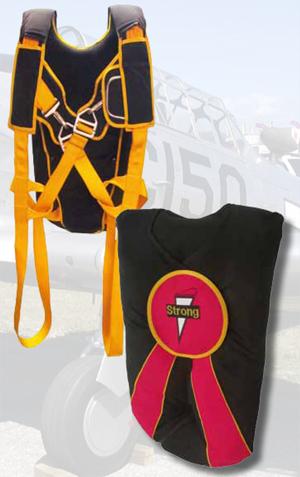Our most commonly asked questions . . .
 If your questions are not answered here feel free to
If your questions are not answered here feel free to
Can I just leave the parachute in my airplane?
The most common damage to emergency parachute systems is sun damage. It's best to store your parachute indoors in a climate-controlled enviromnent, but if you choose to leave it in the cockpit, cover it up.
Learn more ...
At what altitude should I deploy my emergency parachute?
Deployment time and distance depend on many factors including airspeed. You should plan on pulling the ripcord immediately upon clearing the aircraft, but no lower than 500 feet. Generally, opening times are 2 to 3 seconds and altitude loss would be 150 feet (45.7m) to 300 feet (91m). A good practice to have is knowing your “decision deck” or the altitude at which you MUST make your decision to either land with the airplane or leave and use your emergency parachute. Always give yourself a margin for unexpected events.
Learn more ...
Is my parachute steerable?
Yes, Our canopies are steerable for collision avoidance. However, this is not a high performance parachute, it takes about 6-8 seconds to turn the canopy 360 degrees.
Learn more ...
What are landings like under my emergency parachute?
Imagine jumping off of a four foot high object at a walking speed. That will give you an idea of the landing you will have under your parachute. Bear in mind that vertical speed (descent rate) increases with suspended weight and density altitude.
Learn more ...
How often do I have to have my emergency parachute repacked?
Para-Cushion Parachute Systems are designed for a 365-day repack cycle. Your country's laws may dictate a stricter schedule, check your local regulations. In the U.S. current regulations dictate a 180-day inspection and repack cycle.
How do I get my parachute system serviced?
The Para-Cushion must be packed by an FAA certificated Parachute Rigger or equivalent with an appropriate rating (Back or Seat), or returned for factory inspection and repack.
Learn more ...
What is the life of my parachute system?
With proper care and maintenance, your Para-Cushion will last for years. We do not mandate an end of life (Service Life) on our pilot emergency systems. The continued airworthiness of an assembly is at the discretion of the FAA licensed Parachute Rigger’s inspection during re-pack. We recommend returning the system to us every 5 to 8 years for complete inspection and any updates that may be required.
How often should I practice emergency situations?
Ideally you should practice every time you get into and out of your aircraft. With the parachute on, sit in your cockpit and fasten your lap and shoulder belts. Be certain these are over your parachute harness. Wear gloves, helmet and goggles, even headphones if you normally use them. Mentally organize your bailout procedure. Inspect your cockpit for projections or sharp edges that may damage the parachute, or injure you. Consider canopy ejection, oxygen disconnect, or other requirements that you may be faced with. All these things take time, and an emergency leaves you little time for errors.
Learn more ...
What should I do for long term storage?
The best possible way to store your Para-Cushion is unopened inside the carry bag and placed in a temperature controlled, dry environment. It doesn’t matter how long the canopy is kept that way.
Learn more ...